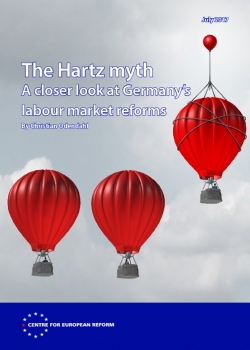
The Hartz myth: A closer look at Germany's labour market reforms
Germany’s labour market and welfare reforms of the early 2000s have gained an outsized importance over time. For some, these reforms put an end to Germany’s social market economy and pushed millions into unsecure, low wage jobs. For others, notably many international observers, these ‘Hartz reforms’ are one if not the main reason why Germany – formerly known as the ‘sick man of Europe’ – is now Europe’s export powerhouse and strongest economy.
#Germany has one of the largest low wage sectors in Europe, #labourmarket reforms are not the reason.
The importance of this debate can hardly be overstated. In Germany, the forthcoming election will in part be fought on the issue of ‘social justice’. Martin Schulz is putting corrections to the Hartz reforms at the centre of his campaign.
In Europe, no other narrative has so persistently shaped the response to the on-going euro crisis as the idea that some countries struggle because they have lost their ‘competitiveness’, and they should therefore reform like Germany in order to grow and reduce unemployment. The election of Emmanuel Macron will test the validity of this narrative, as he is vowing to reform France along German lines. If that narrative turns out to be false, however, he may well fail to deliver growth and employment.
A sober look at the German reforms shows that their economic impact was modest. They targeted weaknesses in Germany’s labour market and benefits system and:
- combined unemployment and social assistance into a single system, to help more people find jobs or retrain;
- curbed incentives to ‘retire early’ by preventing people from claiming generous unemployment benefits before reaching retirement age, thus increasing the employment rate among older workers;
- made job search, training and job centres more efficient, which helped to reduce unemployment by an estimated 1.5 percentage points; and
- provided more incentives to take up work, which increased temporary and marginal employment.
There were fewer negative side effects than are commonly attributed to the reforms. For example, the large low-wage sector – Germany has the largest in the EU after the Baltic States, Poland and Romania – predates the reforms. But the number of people in insecure jobs and at risk of poverty increased after the reforms. The effect on income inequality is ambiguous.
The 'Hartz' reforms in #Germany were not a major reason for German wage restraint or export successes.
Many argue that one consequence of the Hartz reforms was wage restraint, which is why the rest of Europe should follow Germany’s lead in order to gain ‘competitiveness’. But wage restraint started in 1995, not with the reforms in 2004. It was mostly a consequence of high unemployment, globalisation and the threat of offshoring and outsourcing by businesses. Only low wages were pushed down further as a consequence of the reforms.
Nor does wage restraint explain Germany’s subsequent economic recovery and employment growth. The export successes of Germany after 2004 coincided with a worldwide economic boom, notably in emerging markets. Lower prices of German export goods played a role, but German businesses lowered costs mostly through outsourcing, re-organising factories and management, and building supply chains in central and eastern Europe.
And wage restraint came with costs of its own, for German workers but also for Europe. Lower wages meant lower consumption and imports in Germany. As a result, Germany started exporting capital – capital that helped to build up debt and property bubbles elsewhere, which burst and caused widespread economic misery.
If the rest of Europe wants to learn from Germany, it should draw the right lessons from the Hartz reforms.
- Timing is everything, and Germany’s timing of the reforms was impeccable. Not all economies would take off similarly after such reforms.
- The right diagnosis is crucial. In Germany, the diagnosis was incomplete, focusing on important issues in the labour market but ignoring the country’s macroeconomic situation. This could have backfired (but did not, see lesson 1).
- There are smarter ways to reform the labour market during an economic slump. Investment in training and incentives should come first, cuts to benefits and deregulation only when the economy has recovered. Germany got lucky (see lesson 1).
- Labour market and benefits reforms can bring hardship and increase economic insecurity, which should be mitigated right from the start.
- More flexible labour markets do little if anything to boost productivity. Germany failed to complement its labour market reforms with a productivity agenda for those affected most by the reforms.
- Labour unions and works councils that were willing to accommodate themselves to change were crucial for Germany’s adaptation to globalisation. But unions should be strong enough to demand appropriate wage increases. Striking the right balance is not easy, but should be a key concern for policy-makers.
Christian Odendahl is chief economist at the Centre for European Reform.

